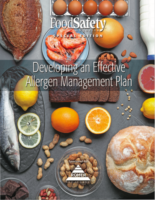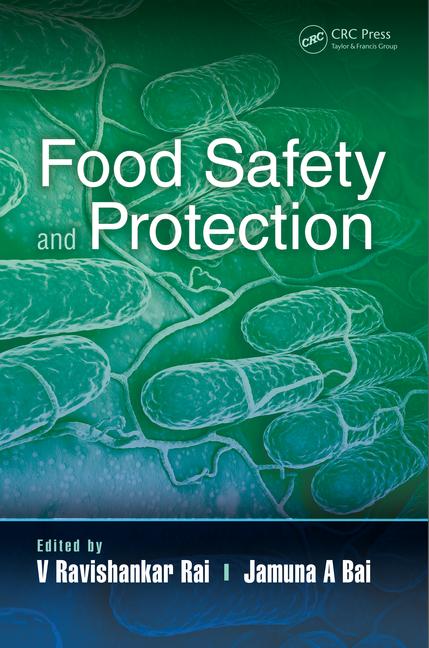Putting Together an Effective Allergen Control Plan

Labeling of foods for the presence of allergens must identify all foods that intentionally contain the particular food or ingredients derived from that food. However, voluntary labeling for the possible presence of the allergen should be reserved for genuine hazards. There has been a proliferation of the use of such precautionary allergen statements, which range in wording from “May Contain” to “Processed in a Facility” to “Made on Shared Equipment.” This increase has limited consumer food choices, and for food-allergic consumers, the tendency to ignore precautionary statements and take risks regarding the foods they choose to eat is on the rise.
According to the Food Allergy Research and Resource Program in 2003,[1] possible processing errors or oversights that result in allergen-containing product contamination are as follows: inadequate cleaning of shared equipment (nonallergen-containing products run after allergen-containing products, resulting in cross-contamination); use of rework (not using “like into like” practices); switching of ingredients (and not following up with an allergen assessment of the new ingredients); labeling terms (using uncommon or incorrect terminology for the top eight allergens); and frequency of Hazard Analysis and Critical Control Points plan review.
It doesn’t matter what the cause—leftover ingredients in a hard-to-reach corner of your processing line, a halfhearted cleaning effort due to employee fatigue or a looming product deadline—any allergen residue not adequately cleaned and removed from your processing line can find its way into the next product on the line, causing your next product to inadvertently contain an allergen not included on the label—and that can have grave consequences. It’s a matter of process design, protocol documentation and thorough validation of cleaning procedures—and your allergen control plan (ACP) needs to account for it all.
Getting Started
As more and more food product recalls are due to undeclared allergens on labels, it is essential that all companies implement an effective ACP to avoid inadvertent allergen cross-contamination, damaging recalls and adverse, or even deadly, effects for consumers. An ACP is a systematic method for identifying and controlling allergens, from the incoming ingredients to the final packaged product in any food processing facility.[2] It is your company’s written documentation regarding the storage, handling, processing, packaging and identification of allergenic foods and ingredients.
The fundamentals of developing an effective ACP in the food plant are discussed below. For other resources, please see “Food Allergen Resources.”
It should be noted that this is not a one-time effort. Your ACP must be implemented, audited, enforced and updated continually.[3] Every time you make a change in a process or a product, assess the ACP and update it if required. For example, every time you hire a new employee or change the job tasks of an employee, make sure he or she understands his or her role in the ACP through training that is documented. Every time you begin working with a new supplier, evaluate the supplier’s ACP and alter yours as needed. If you change or add plants, a new ACP should be developed to reflect these changes.
An ACP is not only about protecting the health and confidence of consumers but about protecting your brand as well.
The Fundamentals
The first step in developing your ACP is to identify people in your organization who understand not only how ingredients enter and travel through your facility but also the vital importance of managing and controlling these ingredients at every stage of production: from choosing suppliers to handling, storage, processing, packaging and labeling.
Let’s look at a few of these critical steps:
Review Suppliers. What comes into your facility from suppliers can have an important impact on the quality and integrity of your food processing procedures—and ultimately can affect the brand. Your ACP should outline expectations, documentation and validation to ensure that your suppliers are diligent and dedicated to the control and management of allergens.
Food manufacturers should obtain copies of product or ingredient formulations, specification sheets or certificates of analysis from suppliers of raw ingredients. When reviewing specifications, you should look for formulations that list ingredients without a sublisting. For example, whipped marshmallow may contain eggs, or soy sauce may contain wheat. In many cases, the final concentration of the allergen contained within another ingredient is so low that it should not cause illness. However, testing to verify the amounts of allergen present will help determine whether actions are needed within the plant. Verify that your suppliers have an ACP.
Raw Ingredient Storage and Color-Coding Systems. Store all allergenic foods or ingredients derived from these foods in an area that is secluded from nonallergenic materials. If this is not possible, require that all incoming pallets are shrink-wrapped to prevent cross-contamination opportunities, such as leakage from torn bags. Carefully store partially used bags and containers of allergen-containing ingredients in segregated areas. Verify that production staff seals all partially used bags and containers.
Allergen identification is a helpful tool for all employees in a production facility. All raw ingredients that are allergens should be labeled with a tag that states “allergen.” This will help avoid substitution mistakes (e.g., wheat flour for soy flour). A color-coded tag also may be used. It is recommended to place color-coding charts throughout the production area, especially above all equipment and near storage areas for easy identification by plant personnel. Store allergenic compounds on bottom racks or points nearest to the floor to avoid spilling allergenic ingredients onto nonallergenic items below.
Dedicated scoops, utensils and bins used for specific ingredients can also help keep allergens segregated. By combining both bright colors and words, you can reach employees that may be colorblind (words on labels included) or those who speak English as a second language (color coding).
Production. The very act of processing includes a number of opportunities and risks for allergenic ingredients to be introduced into the wrong food product. Human error in formulation is only one risk factor. Intelligent scheduling of production and dedicated equipment and processing lines can go a long way toward preventing contamination. It is important to consider factors such as when allergenic ingredients are introduced into the process and the flow of ingredients through the plant that could inadvertently carry allergens from one part of the facility to another.
Two main methods are used to control allergens within the plant. The first involves producing the allergen-containing product as the last product on a production line. If all products manufactured contain the same allergen, a label declaration is enough to control the allergen. However, if only one product produced contains an allergen, that product should be run last. If one product does not contain an allergen but the rest of the products do, run this product first after a complete wet cleaning procedure or carry out a wet clean process between the allergen-containing product run and the nonallergen-containing product run.
The second method used for controlling allergen cross-contamination is to perform a wet clean prior to or following the run of an allergen-containing product on a specific line. It is the protein component within the food that is responsible for the immunological symptoms of an allergic reaction in humans. As such, the goal of the processor is the complete removal of allergenic proteins. When opting for a wet cleaning method, first assess the food items that are processed on shared equipment. If a wet clean is not possible between runs, the first portion of the next run should be discarded. When cleaning operations are not performed between allergen- and nonallergen-containing products or between different allergen-containing products, a parts-per-million (ppm) analysis must be conducted to establish the safety of the products that don’t list allergens on the label. If a product contains allergenic compounds at a level of 5 ppm or greater and this allergen is not listed on the label, allergenic symptoms may result in extremely sensitive individuals who ingest the product.
Evaluation of Program Effectiveness. Changes in raw ingredients, suppliers and customer demands result in the need for a continuous reevaluation of the effectiveness of your ACP. Incorporating routine auditing practices, both for your suppliers’ and your own in-plant operations, is important to continuously verify that the program is working effectively.
Label Review Policies. The only way consumers know of potential allergens in your product is when they read the label or packaging. They are placing their trust—and in some cases, their very lives—in your hands. Proper labels not only help protect your consumers but also protect your company from costly recalls, regulatory scrutiny and potential liability.
Develop a system for maintaining labels that are placed on foods containing allergens in easy-to-identify areas. Discard old labels. Conduct a thorough review of current recipes and match them with the currently used labels. An excellent way to help manage allergen labeling is to build a book containing raw ingredient specifications, formulations and finished product labels. When a raw ingredient statement changes, you should be able to cross-reference it against finished product labels and understand what products and labels would be affected by the change.
Staff Training and Education
Ultimately, the effectiveness of your ACP comes down to people: Trained employees and managers can be your greatest assets. You want employees who understand not only what to do, when to do it and how to do it but, more importantly, why it needs to be done to protect your company and the consumers who trust your products. Training is essential and must be an ongoing commitment, for both new and seasoned employees.
Allergen education may be easily incorporated into Good Manufacturing Practices and training. As always, after education sessions, documentation of the employee by signature, date, trainer and materials covered should be available for review. Allergen education should be conducted throughout the company.
Conclusions
An effective ACP depends on keeping allergenic foods and ingredients separate from all other products and ingredients from the time they enter your facility until they are introduced into the production line and beyond. Every attempt must be made to visibly identify allergens and isolate them—at every step—from other foods, ingredients and equipment.
Ultimately, an effective ACP requires the understanding and buy-in of all food production staff. A single department is not responsible for the maintenance of an ACP. Corporate managers, plant managers, quality control, production, cleaning and sanitation, and purchasing departments are all responsible for the development, implementation and upkeep of an ACP.
References
1. www.farrp.org.
2. www.food-safety.com/magazine-archive1/december-2003january-2004/writing-and-implementing-an-allergen-control-plan/.
3. www.foodallergy.org/sites/default/files/migrated-files/file/food-processor-plan.pdf.
Looking for a reprint of this article?
From high-res PDFs to custom plaques, order your copy today!






.webp?t=1721343192)

